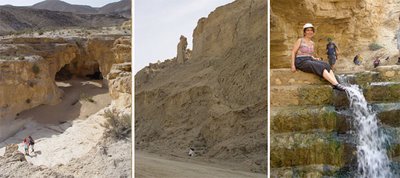The Negev desert in southern Israel is a remarkable arid region.
Comparatively small, the Negev has had, however, an intriguing history of settlers, occupiers and passers through including Nabateans, Romans, Byzantines, Ottomans, British, Bedouin and Israelis. This rich socio-historical tapestry is linked to a landscape that is well endowed with historical sites, sublime landscape scenery and a robust and varied fauna and flora. The great variety of wildlife to be found here is intricately woven into the past and present of the landscape that results from an interaction between the people, the geography and climate.
 Our first station was in the Mamshit National Park, where we could observe the ruins (partly reconstructed) of ancient city of the Nabateans.
Our first station was in the Mamshit National Park, where we could observe the ruins (partly reconstructed) of ancient city of the Nabateans. We were almost late to see flowering desert. Though it happens in March, in the 20-th the desert was already yellow and brown. Few blossoming bushes could be seen in oasis along streams. The weather was hot, still not as hot as to disturb us to hike.
We were almost late to see flowering desert. Though it happens in March, in the 20-th the desert was already yellow and brown. Few blossoming bushes could be seen in oasis along streams. The weather was hot, still not as hot as to disturb us to hike. We enjoyed the fascinating scenery composed of mountains, streams valleys, caves, colored sand and rare trees.
We enjoyed the fascinating scenery composed of mountains, streams valleys, caves, colored sand and rare trees. The Dead Sea, the lowest point on earth and the largest "Natural Spa" in the world, is also one of the world's true natural wonders and a unique tourism destination.
The Dead Sea, the lowest point on earth and the largest "Natural Spa" in the world, is also one of the world's true natural wonders and a unique tourism destination.


No comments:
Post a Comment